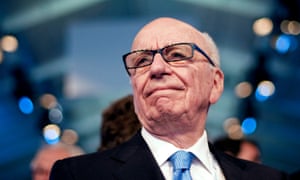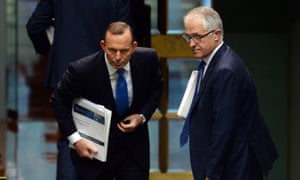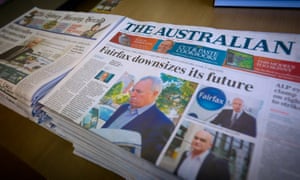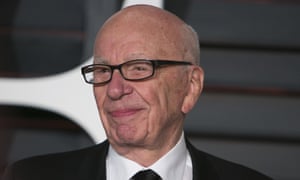
In the third part of our series, we examine how Rupert Murdoch’s primary interest in politicians is not always political but often commercial
Long before he felt the heat of what he believes was News Corp’s attempt to exert political influence, the former prime minister Malcolm Turnbull had seen at close hand how the organisation exerted pressure in defence of its commercial interests.
Back in 2015, Turnbull, then the communications minister, incurred the wrath of Australia’s biggest media company after he proposed loosening media ownership restrictions, while ignoring News’ calls for its pay television joint-venture Foxtel to get more access to sports rights.
A few months earlier he had promised, to the mirth of the media companies at the meeting, that he would move forward with changes to the media ownership laws only if there was “consensus” – and News was far from happy.
The Australian newspaper quickly reported that Turnbull’s decision “has infuriated some media companies”, with executives “bewildered” that Turnbull had decided to press ahead after he promised he would only do so with “high-level consensus”.
Rupert Murdoch, the executive chairman of News Corp, took to Twitter: “Aust! Turnbull’s plans to scrap certain rules suit buddies at Nine. Can’t oppose dumping all regs but not this. Nice to see how MT plays.”
The Australian warned: “The intervention will further fuel speculation among Liberal MPs about the communications minister’s capacity to maintain good relations with some media companies.”

Back in 2015, Turnbull, then the communications minister, incurred the wrath of Australia’s biggest media company after he proposed loosening media ownership restrictions, while ignoring News’ calls for its pay television joint-venture Foxtel to get more access to sports rights.
A few months earlier he had promised, to the mirth of the media companies at the meeting, that he would move forward with changes to the media ownership laws only if there was “consensus” – and News was far from happy.
The Australian newspaper quickly reported that Turnbull’s decision “has infuriated some media companies”, with executives “bewildered” that Turnbull had decided to press ahead after he promised he would only do so with “high-level consensus”.
Rupert Murdoch, the executive chairman of News Corp, took to Twitter: “Aust! Turnbull’s plans to scrap certain rules suit buddies at Nine. Can’t oppose dumping all regs but not this. Nice to see how MT plays.”
The Australian warned: “The intervention will further fuel speculation among Liberal MPs about the communications minister’s capacity to maintain good relations with some media companies.”

For those who have followed how News deals with public figures, this was tantamount to a threat.
The prime minister at the time, Tony Abbott, who is close to Lachlan Murdoch, hastily filed Turnbull’s proposal in the bottom draw.
Fast forward to 2016 and Turnbull had become prime minister. He again decided to have a tilt at getting rid of the Keating-era cross-media rules but again without addressing the anti-siphoning rules that News so badly wanted changed.
The Murdoch press told him in no uncertain terms that reform without changes to the anti-siphoning rules, News would remain “disappointed” and did not regard it as “genuine reform”.
It would take another two years before the media ownership laws passed. By 2017, the media landscape looked very different and News had bigger fish to fry. But more on that later.
Political favours
Nick Davies, the Guardian journalist who broke the hacking scandal, wrote in his book Hack Attack that outsiders to the media often misunderstand the power of Rupert Murdoch.Davies argues that Murdoch’s use of power is far subtler than outsiders imagine.
He argues that those close to Murdoch say he has something very deep that drives him very hard – perhaps wanting to prove himself to his long-dead father, Sir Keith – and that this compelled him to build a bigger and bigger business.
“With that in mind, they say that his primary interest in politicians is not political; it’s commercial,” Davies writes.
“He may be a highly political animal, they say – obsessed with the details of life in the corridors of power and personally possessed of some extremely rightwing opinions – but what he most wants from politicians is favours for his business. He’ll betray his own principles, he’ll embrace politicians for whom he has very little respect, just as long as they have the power to help the company get bigger.”
In practical terms, Davies says that often comes down to a repeated demand to be freed from regulation and for the state to be cut back to make way for private enterprise.
But sometimes News seeks regulation to protect its own position. Like right now, when News is angling for regulation to thwart the advance of social media juggernauts such as Google and Facebook.
News’s campaigns to protect or further its commercial interests are often cloaked in principle that sometimes obscures another financial interest beneath.
For instance, Telegraph readers were told that its 2014 campaign to cut NSW’s racing tax to the same level as Victoria was for the good of the state and would help boost a $3.3bn industry. The issue was largely ignored by the rest of the media with the exception of Alan Jones, a friend of Racing NSW’s chairman, John Messara.

What the Telegraph did not highlight was its close relationship with Racing NSW, which at the time paid both the Telegraph and the Sydney Morning Herald millions each year to print and distribute the form guide each week.
Jones and the Tele also took up the cause of the greyhound racing industry when the former premier Mike Baird proposed a ban. There was genuine unhappiness from greyhound trainers about the ban but there was also genuine concern about animal welfare. The Tele championed the side of the racing industry.
In a statement to Guardian Australia, News Corp said: “Both Fairfax and News Corp have had commercial arrangements in place for more than 10 years to publish the NSW form guides. For the Daily Telegraph, the cost of more than 60 pages of racing form is jointly funded by Racing NSW and TAB. They carry the logos of Racing NSW and TAB and are actually called TABform liftouts. The liftouts advise readers that much detail is provided by Racing NSW and TAB.”
Fairfax v News and the war within
Sometimes, however, News’s interests are overt, such as its long-standing rivalry with Fairfax Media, manifested in literally thousands of words about the ineptitude of the company and its executives.As Fairfax took steps to cut costs in the 2000s and moved to “a digital-first model”, executives were regularly attacked by the Australian’s media columnists for running a doomed and stupid strategy.
The critique of Fairfax’s business model – a legitimate issue for the business pages – descended into personal attacks on Fairfax executives.
“When Fairfax was the real target in the 2000s, executives used to feel there was a real irrationality in the competition because there was no alternative but to win,” says one former senior Fairfax executive.
“They had bottomless pockets with which to fight – like the war over free commuter newspapers. They could not have gone back to Rupert and have lost. In contrast, Fairfax had to justify it to shareholders. News was ferocious.”

Rupert Murdoch decided to move Kim Williams, a long-term News Corp executive, who had run first Fox Studios and then Foxtel, to the top job in the print empire at Holt Street in Sydney’s Surry Hills.
The urbane Williams, with a long history in film and television, was not cut from the same cloth as most of the senior executives at Holt Street.
He was well connected within Labor circles – he is married to Gough Whitlam’s daughter – and had spent much of his life in the arts world. He would prefer to attend a concert than go to the pub or the footy.
Despite coming with a mandate to bring about change, he quickly found himself at loggerheads with the editors – and later with Murdoch.
In his memoir, Rules of Engagement, Williams described Holt Street as a “feudal” world where editors ruled their own mastheads and had a direct line to Murdoch.
Williams’ plans to break down the silos, focus on the digital future and streamline the way News operated in Australia caused open rebellion.
Williams knew it would be difficult. When offered the job, he is said to have asked Murdoch who would be in charge. “You, of course,” the mogul had replied. “I’m glad to see you have a great sense of humour,” Williams replied.
But Williams soon found that the old power structures of News were deeply embedded in its DNA.
Chris Mitchell, then the editor of the Australian, writes in his book, Making Headlines, that he tried to explain the realities of the business to Williams: of the $162m revenues, only $8m came from digital advertising. The lion’s share came from print.
“I left Kim’s office determined that despite my long reluctance to involve Rupert in the day-to-day running of my paper I had to let the boss know what his Australian CEO was thinking.” The other editors joined in.
Williams’s plans drew vicious criticism, particularly from the Australian Financial Review’s Joe Aston, who is well connected with News Corp editors.
The criticism inside News was more subtle. Editors were regularly in touch with Murdoch about what they saw as an assault on their sovereignty – and, according to Mitchell, Murdoch backed the editors, saying that they understood their audiences better.

The arrival of Col Allan, one of Murdoch’s inner circle, in late July 2013 to run the tabloid election coverage during the 2013 federal election campaign, was a blunt sign from Murdoch that the editors were back in the driver’s seat.
Allan’s influence was immediately apparent: “Kick this Mob Out” screamed the front-page editorial, calling for readers to exercise their votes to get rid of Kevin Rudd.

By August 2013, Williams was gone. One insider said Williams walked the plank for two key reasons: a tin ear for the ever-present internal politics at News, and a collapse in sales revenues.
Even as Williams launched his memoir, which barely touches on his time at News, a well-timed leak about the disastrous drop in revenues at the Australian under his watch emerged.
Williams has been largely silent about his experience at Holt Street other than to say that everyone, from Murdoch down, was aware of what he was trying to do.
In an interview with Eleanor Hall on ABC Radio, he was asked how he felt about the hatred from News now directed toward him.
“Well, certainly there seems to be an unseemly enthusiasm to engage in public assassination of me and my period there, which, I frankly, I look at it with some bemusement and probably a little bit of disappointment.”
Digital headwinds and the NBN
History will be the judge of whether hastening towards a digital future or holding on to print as long as possible was a better strategy for long-term survival.But like all media companies News is being buffeted by the forces of digital disruption.
Ebitda in news and information services – the segment that includes the company’s Australian and international newspapers – declined $US22m or 5% year on year. News says its subscription strategy is working and its digital revenues are growing, while advertising continues to decline.
The 2018 results also show that Foxtel revenues are under pressure thanks to the arrival of Netflix, Stan and myriad platforms that divert viewers’ attention away from cable TV.
Rudd believes it was his plan for the national broadband network, which allowed these new players to compete with Foxtel, that set him on an irretrievable collision course with News in 2009.
"By the 2013 election, Turnbull had got into bed with News ... It was just so shameless"
“Initially their concern was in protecting advertising but, as the rivers of gold dried up, this focus shifted to sporting rights as that related to the future of the cable network,” he says. “Foxtel was subsidising their Australian operations. That’s where the NBN came in.
“I commissioned Ken Henry, the secretary of Treasury, to do a report. He made a recommendation in 2009 that we should construct fibre to the premises as this was the best way to achieve value for taxpayers.
“Having built it, we then proposed to throw it open to private service providers – that was an economic recommendation from the Treasury. It was also the best return to the taxpayer.” Within two to three weeks, News unleashed an almighty broadside, he says.

“Foxtel was delivering massive profits of $1.1bn and that was being used as a cross-subsidy by Rupert for his newspapers,” he says. “What they said was this would allow Netflix to get into the market and deliver on-demand services.
“They opened fire at every level: that it was a huge waste of taxpayers’ money, that we would be ripping up the suburbs.”
The Australian, led by Mitchell, had already run a campaign criticising the Rudd government’s spending under its stimulus package designed to stave off the global financial crisis. By 2009, it had morphed into a detailed critique of Rudd’s then $44bn NBN.
The Australian ran almost daily stories about its problems, detailing how costs were blowing out and the rollout was behind schedule.
“By the 2013 election, Turnbull had got into bed with them,” Rudd says. “He came up with his ridiculous plan of fibre to the node. It was just so shameless.”
Turnbull launched his new cut-down, hybrid NBN – which would use the existing cable network and telephone wires for the last portion to the home – at Fox Studios in August 2013. It had a price tag (then) of $29bn and a completion date of 2019.
News Corp executives have strongly disputed Rudd’s account of what drove the critical coverage. There are, of course, multiple problems with the NBN and the Australian, in particular, continues to cover the problems with the hybrid model. But columnists such as Nick Cater sheet the blame for the problems back to Rudd, arguing that the government should not have built the network at all.
The war against Aunty
More recently, News has redefined its enemy in the Australian media market as the national broadcaster.“No one ever got into trouble at News for attacking the public broadcaster,” the former ABC managing director Mark Scott remarked to colleagues as they came under siege from a News Corp campaign during his tenure.
But News’ war against the ABC and its funding has escalated as the ABC has redefined its mission as a digital media company and been granted extra funding to realise it.
The first battleground was the ABC’s free 24-hour news service, launched in 2010, which pitted the national broadcaster in direct competition with Foxtel’s Sky News.

But it is the ABC’s pursuit of online audiences and its push on to various digital platforms that have prompted the loudest complains from News. The ABC’s website now regularly rates third behind news.com.au and ninemsn.com.au
“We’re not a threat to advertising revenue but we are taking eyeballs and that’s what has upset News,” said one ABC insider.
News has responded by both investing in its own site and running an intensive campaign in the corridors of Canberra and in its news pages to convince the federal government that the ABC is both biased and competing unfairly using taxpayer dollars.
News’ columnists regularly take up the chant of bias, inefficiency, creeping populism in programming and unfair competition using taxpayers dollars.
It is not just a national campaign but a global one. Both Lachlan and James Murdoch have attacked the ABC and the BBC in public speeches.
“The corporation is incapable of distinguishing between what is good for it, and what is good for the country,” James Murdoch said in his 2009 James MacTaggart Memorial Lecture. “Funded by a hypothecated tax, the BBC feels empowered to offer something for everyone, even in areas well served by the market. The scope of its activities and ambitions is chilling.”
News’ change of heart on anti-siphoning
So what prompted News to relent on changes to the anti-siphoning laws that it said were essential to its support for media ownership reform?By 2017, News had bigger fish to fry.
The ailing Ten Network, controlled by Lachlan Murdoch and fellow media mogul Bruce Gordon, had been placed in receivership in June of that year.
But no sooner than the receivers were called in, Murdoch and Gordon found themselves facing competition from hedge funds such as Oaktree, which had successfully recapitalised the Nine Network and the US network CBS. Murdoch urgently needed a change to the media ownership rules to buy Ten in the fire sale.
But getting the rules quickly through the Australian Senate proved beyond even Murdoch’s power. In the hiatus, CBS proved a wily opponent, winning over Ten’s staff, who made up the bulk of the creditors. Despite court challenges, CBS won control of Ten.

There were also larger existential threats on the horizon: the ABC, Google, Facebook, Amazon and Netflix.
So News went to work to convince the Turnbull government to crimp its new competitors.
During the negotiations over the recent changes to the media ownership laws, One Nation senator Pauline Hanson insisted that her vote was contingent on an inquiry into the “competitive neutrality” of the ABC and SBS.
Lobbyists for rival media groups say News Corp had been highly influential in sowing the idea with Hanson. Free-to-air TV wanted SBS included because it was cutting into their shrinking advertising dollars and picking up popular series such as The Handmaid’s Tale.
“There is a conviction [at News] that the market will provide, so the government should step away,” said one former ABC executive. “If you stand in the way of that view, or if you stand as an alternative to that view, like the ABC, then you will crushed, or they will come after you with a vengeance.
“It’s nothing personal, it’s just business.”
News also wielded its influence over a fund to promote diversity that senator Nick Xenophon insisted was the price of his support.
And then there is the inquiry by the Australian Competition and Consumer Commission into digital platforms such as Google, Facebook and Amazon. News was not alone in pushing for an inquiry. It is a concern shared by other Australian media companies as they see the multinational social media networks hoover up digital advertising dollars.
Those concerns are now being aired in the Australian Competition and Consumer Commission’s digital platforms inquiry.
“Our ability to attract subscribers and advertisers, and in turn obtain a return on our investment in content, is being seriously undermined by platforms which host our content without our permission, make it available for free to our entire potential subscriber base, and use that content to attract advertisers away from our platform,” News Corp’s Foxtel said.
If it was left unaddressed it would seriously affect the economics of local media companies, it warned.
In its corporate submission, News Corp stopped short of calling for additional regulation but blamed the social media platforms for fake news, warning that digital platforms were undermining the sustainability of news and journalism as a private enterprise.
From New York, Murdoch issued a statement saying that “if Facebook wants to recognise ‘trusted’ publishers then it should pay those publishers a carriage fee similar to the model adopted by cable companies”.
Behind the scenes, News is now lobbying for just such a model.
Meanwhile News and other media companies, fearing the deep pockets of Facebook, Google and Amazon when it comes to bidding for sporting rights, is pushing for the hated anti-siphoning rules to be retained and extended beyond Foxtel to the multinational digital platforms.
And it has reason to be fearful. In the UK, Amazon outbid Sky News for a new package of TV rights to the ATP Masters tennis from 2019, which it intends to stream on its video platform, Amazon Prime.
In the US, Facebook has struck a deal with Major League Baseball, which gives the social networking site exclusive broadcast rights to 25 games for US-based users, the first digital-only broadcast deal struck by a major US sports league.
The pay television industry argues there is nothing stopping these players from buying rights to sports on the anti-siphoning list and the regime only impacts Foxtel. Rights to the majority of major codes on the list are locked up until after 2020 but, given the rapid pace of technological change in the media environment, predicting who will bid next time around is impossible.
No comments:
Post a Comment